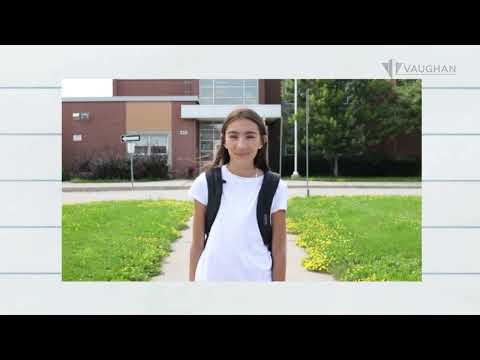Safety Zones
Road safety remains a leading priority for the City of Vaughan – especially when it comes to protecting our most vulnerable road users.
The City continues to implement various traffic calming measures to enhance our existing programs and ensure all road users, including those who walk, cycle, take transit or drive, are kept safe.
Community Safety Zones
A Community Safety Zone is a designated stretch of roadway marked with provincially legislated signs where public safety is of special concern. This can include roadways near schools, neighbourhoods, daycare centres, playgrounds, parks, hospitals and seniors’ residences. A Community Safety Zone is meant to encourage drivers to slow down and improve safety for all road users.
The purpose of a Community Safety Zone is to indicate to drivers that they are within a zone where fines are increased through a special designation under the Ontario Highway Traffic Act. “Begins” and “Ends” signs are posted to show the legal speed limits within the area. The rules of the road do not change within a Community Safety Zone; however the penalties for violations are increased.
Community Safety Zones Policy
On Dec. 12, 2023, Council endorsed the Community Safety Zones Policy (PDF), which outlines a two-step process for the City to identify and determine the suitability of a location as a Community Safety Zone.
Sites were selected based on the:
- traffic volume, including heavy truck traffic.
- number of traffic lanes.
- sidewalk length.
- number of bus stops.
- traffic speeds and posted speed limits.
- collision history.
Under the policy, all school zones in Vaughan will be designated Community Safety Zones.
Vaughan currently has over 100 Community Safety Zones. Visit our interactive map to view Community Safety Zone locations City-wide.
School Zones
As students make their way to and from class, there is more pedestrian and vehicular traffic on the road. It is important for drivers, parents and children to be alert, follow the rules of the road, and walk safely – especially in school zones.
-
Answer
- Walk young children to school.
- Encourage children to always obey the crossing guards.
- Walk, don’t run, when crossing the street.
- Pay attention to vehicular traffic while walking along or crossing roads.
- Turn ear buds off and do not look down at phones when crossing intersections.
- Obey all traffic rules and signals.
- Ensure you are visible to drivers and cyclists, and make eye contact once they have stopped before crossing.
- Cross at designated crosswalks, crossovers or controlled intersections.
- Be mindful of slippery conditions on sidewalks and roadways.
-
Answer
- Reduce speed in school zones, especially when slippery conditions are present, and be ready to stop at all times.
- Ensure to give yourself enough time to get to your destination.
- Expect the unexpected. Children may cross the street at the wrong place, run into traffic or ride a bike in front of a vehicle without warning.
- Stop for school buses and be aware of children running in front of or behind buses.
- Avoid U-turns in school zones.
- Do not pass other vehicles in a school zone.
- Obey the rules of the road, including posted speed limits.
- Abide by all parking and traffic regulations in school zones.
- Obey crossing guard signals and yield to pedestrians.
- Pay attention to the surroundings. Watch for and yield the whole roadway to pedestrians when approaching a pedestrian crossover. Failing to do so may result in fines of up to $1,000 and four demerit points.
- Avoid distraction within the vehicle and ensure children are secured in a correctly installed child restraint seat.
- Ensure children exit by the passenger side of the vehicle.
- Keep fire routes and bus zones clear.
- Leave nine metres (or 29 feet) between the car and the crosswalks and/or stop signs when parking. Parking too close to these locations makes it difficult to see children when crossing the road.
- Avoid double parking in school zones.
- Watch for signs indicating "No Stopping" and "No Parking."
- Stay back 0.6 metres (or two feet) from private driveways to avoid upsetting residents.
- When cycling or using a micromobility device, dismount before crossing the street.
Safer School Zones Plan
As part of MoveSmart, the City of Vaughan is committed to creating safer, more accessible school zones for students, parents and the community. To support this plan, the City hired an independent consultant to develop a Safer School Zone Plan (SSZP), which aims to improve safety for vulnerable road users in school zone areas.
The Safer School Zone Plan is a strategy designed to enhance safety in school zones across Vaughan. This plan establishes a consistent approach to assessing and improving school zones, while encouraging students to engage in active school travel.
The plan is now complete and City staff are working to implement its recommendations.
Goals and Implementation
- A primary goal of the SSZP is standardizing measures in and around school zones across the city.
- City staff will develop an internal School Zone Guideline to assess and execute best practices for both existing and new school zones.
2. Another critical goal of the SSZP was to increase active school travel among students by focusing on behavior change.
Implementing site-specific recommendations from the plan, categorized into short-, medium-, and long-term improvements, including:
- additional pavement markings
- signage upgrades
- new pedestrian crossovers
With the support of this plan, advancements have been made to expand Vaughan’s Active School Travel program into new schools.
The development of a standardized guideline ensures a consistent approach to school zone safety. By promoting walking and cycling, the Active School Travel program helps manage traffic congestion and supports environmental sustainability.
Additional Resources
- Ministry of Transportation: Pedestrian Safety
- School Zone Safety - Postcard (PDF)
- School Zone Parking and Driving Regulations - Brochure (PDF)
- York Catholic District School Board
- York Region District School Board
- York Region Traffic Safety Program
- York Regional Police
- York Regional Police Road Watch Program



